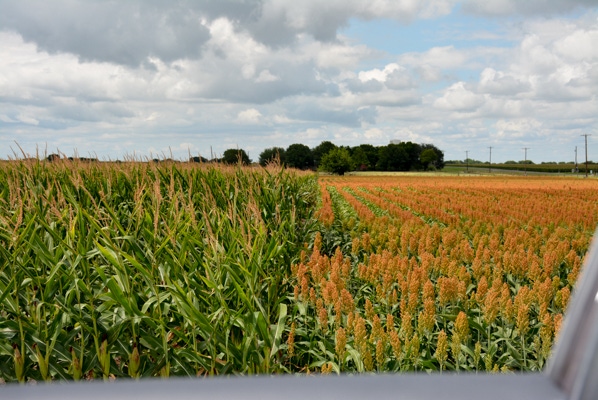July 6, 2018

Central Kansas farmers are being warned to scout for chinch bugs after reports of hefty numbers of the pest on corn and sorghum have surfaced in Lincoln and surrounding counties. While Kansas State Extension specialists say corn is more tolerable to chinch bug damage in later stages of development, younger sorghum plants offer prime food source for the insects.
Sandra Wick, Kansas State University crop production specialist, says with wheat harvest wrapping up, the pests are quickly moving out of harvested wheat fields and into adjacent corn and sorghum.
"All life stages of chinch bugs seem to be extremely active at the present time in both corn and grain sorghum. Nymphs and adults started migrating out of wheat fields at least two weeks ago, moving into any adjacent corn or grain sorghum fields. Those smaller-reddish nymphs have grown considerably since then, and are now late instar nymphs or adults," she said.
Wick says recently-matured adults are mating and eggs have already been noted in some sorghum. As these eggs hatch, untreated outbreaks of chinch bugs will become a greater problem. She says recent rains have enhanced growing conditions, and that could help increase plant's tolerance to chinch bug feeding. But eggs can hatch as late as October, and females lay up to several hundreds of eggs.
"Female reproductive potential varies greatly from year to year and may be affected by the host plant quality during development. While eggs can hatch much later in the growing season, generally in each generation the majority are laid over a two to three-week period," Wick noted.
Wingless nymphs hatch from eggs and develop through five stages for about 30 days before becoming adults. The entire life cycle can occur in about six weeks or longer, depending on temperature. Two to five or more generations can occur annually.
Feeding punctures
Chinch bugs puncture vascular tissues to extract plant juices and secrete digestive enzymes that cause the break-down of surrounding plant tissues. Feeding punctures also can allow pathogens to enter the plant. Consequently, damaged plants present a variety of symptoms including stunting, yellowing, wilting, and necrotic lesions.
"Older nymphs are larger and cause more damage than younger ones. The effect of nymphal feeding depends to a large degree on the health and nutritional status of the plants. Growth stage and water balance are critical because small or drought-stressed plants have less ability to tolerate or recover from chinch bug feeding damage. The chinch bug feeds on a wide variety of grasses, including many cereal and forage crops," she said.
Wick adds that the risk of first generation damage is greater where sorghum is planted next to thin stands of wheat. Seedling sorghum is most vulnerable, and seven to 10 bugs per plant will cause stunting, poor root development and stand reduction. Larger plants can tolerate more bugs, but severe infestations can cause stunting, lodging, and yield loss.
Timely applications
Timely applications of foliar insecticides can be used to rescue corn or sorghum fields invaded by migrating chinch bugs on the edge of the fields to help prevent movement into the field. Most currently approved materials have good efficacy against chinch bugs, if three factors are considered.
First, it is important to use the full recommended rate of the selected insecticide, preferably delivered in 20 to 40 gallons of water per acre. High gallonage ensures good plant coverage and enhances the movement of material into protected plant parts such as leaf sheaths, which increases the probability of contact with bugs.
Another important "rule of thumb" is it should be delivered with properly adjusted and calibrated equipment. And [the third requirement] the timing of the insecticide application is critical. Early morning applications are preferred because winds tend to be calmer (reducing drift), temperatures are cool, reducing volatilization of chemicals, and a large proportion of the chinch bug population will be on the plants and exposed to the application.
It is best to treat promptly as migrations begin and before significant numbers of bugs enter the field. Wick notes that treating plants much after the V6/V7 (corn 6 and 7 leaves) growth stages is not as effective as treating smaller plants.
"No natural enemies of chinch bugs can reliably reduce or control large populations when conditions are favorable for their development. Predation by quail and other birds can be conspicuous, but likely has little effect on bug population growth," Wick reports.
You May Also Like




